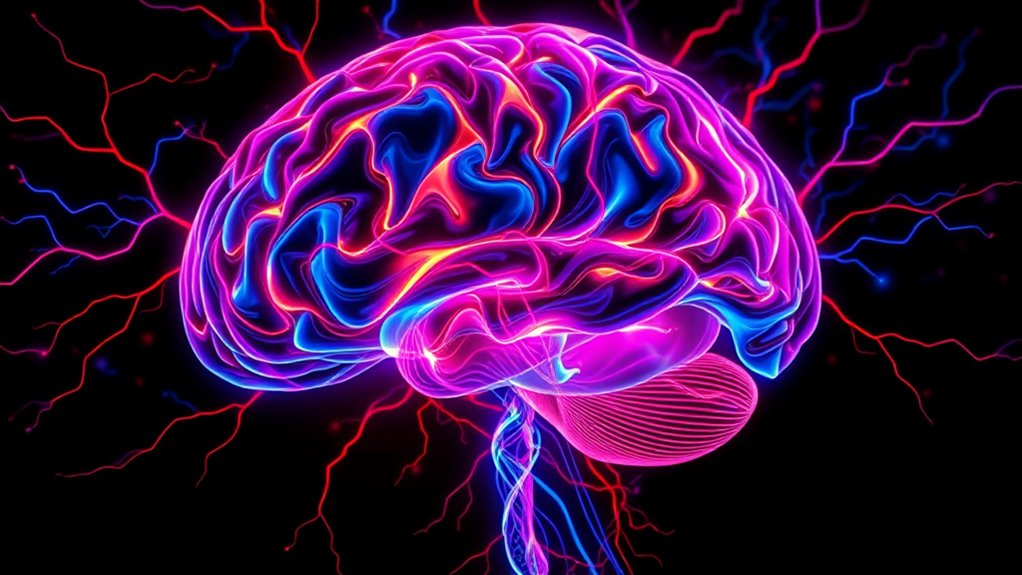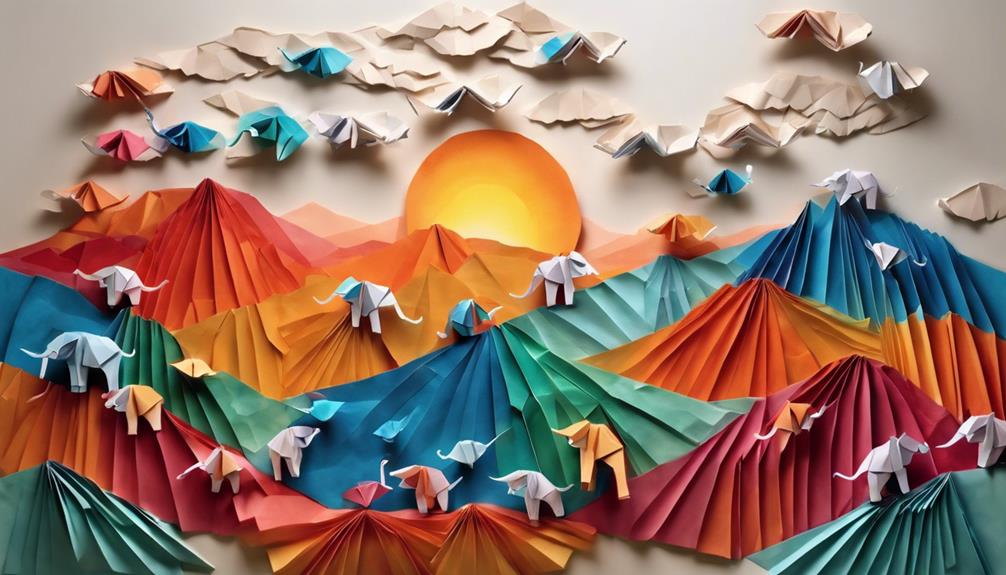The neuroscience of creativity shows that it comes from dynamic interactions between brain networks and neural plasticity. Your brain shifts between the default mode network, involved in internal thought, and the executive control network, which keeps you focused. This flexible switching fosters idea generation and critical thinking. Neural plasticity rewires your brain with each creative effort, helping you develop new perspectives and insights. To explore how these processes shape your creative potential, keep exploring what science reveals.
Key Takeaways
- Creativity arises from dynamic interactions between the default mode network and executive control network in the brain.
- Neural plasticity enables the brain to rewire and adapt, fostering innovative thinking and idea generation.
- Moments of insight involve heightened neural plasticity, breaking habitual patterns and creating new neural pathways.
- The fluid and adaptable nature of brain network interactions supports the emergence of novel ideas and solutions.
- Understanding neural mechanisms helps in developing environments and habits that enhance creative potential through brain reconfiguration.

Have you ever wondered what happens in your brain when you come up with a brilliant idea? It turns out, your creativity hinges on complex brain network interactions that work together in dynamic and adaptable ways. Your brain is not just a single region firing off; instead, it’s a highly interconnected system where multiple networks communicate seamlessly. When you’re in a creative flow, the default mode network, responsible for daydreaming and internal thought, collaborates with the executive control network, which keeps you focused and goal-oriented. This interplay allows you to generate novel ideas while maintaining some level of critical thinking. These brain network interactions are fluid, shifting as needed, which is essential for the creative process.
Creative ideas emerge from dynamic interactions between brain networks and neural plasticity.
Neural plasticity plays an essential role here. It’s the brain’s ability to reorganize itself by forming new connections and strengthening existing ones. This flexibility means your brain can adapt based on experience, learning, and even your current mental state. When you engage in creative activities, neural plasticity allows different regions of your brain to rewire themselves, enabling you to see problems from new perspectives and come up with inventive solutions. Over time, as you repeatedly practice creativity, your brain becomes more efficient at facilitating these connections, making it easier to generate ideas and think outside the box. AI security advances, such as robust safety measures, can also influence how neural plasticity supports innovative thinking by protecting cognitive processes from external threats.
During moments of insight, your brain’s neural networks exhibit heightened plasticity. This heightened state can help you break free from habitual thinking patterns, opening up pathways to innovative ideas. It’s as if your brain is rewiring itself on the fly, creating new routes for information flow. This adaptability not only fuels immediate creative breakthroughs but also enhances your overall ability to think creatively in the future. The more you challenge your brain with diverse experiences and problem-solving tasks, the stronger and more flexible your neural connections become.
In essence, your creativity emerges from the intricate dance of brain network interactions and the brain’s remarkable capacity for neural plasticity. These elements work together to enable you to connect disparate ideas, reconfigure your thinking, and produce original insights. Understanding this neural foundation can help you harness your creative potential—by fostering environments and habits that promote flexible thinking and ongoing brain rewiring. So, every time you have a new idea or solve a problem creatively, remember: it’s your brain’s network interactions and neural plasticity at work, constantly shaping and reshaping your capacity for innovation.
Frequently Asked Questions
How Do Different Brain Regions Collaborate During Creative Thinking?
During creative thinking, your brain regions collaborate through dynamic brain network interactions, integrating diverse cognitive processes. The right hemisphere often specializes in visual and abstract thinking, while the left handles language and logic. These hemispheric specializations work together, with the prefrontal cortex coordinating ideas, and the default mode network sparks insight. This seamless teamwork enables you to generate novel ideas and solve problems creatively.
Can Neuroscience Explain Why Some People Are More Creative Than Others?
Imagine your brain as a bustling city with interconnected roads. People with greater brain connectivity and cognitive flexibility can navigate these roads more freely, leading to more creative ideas. Neuroscience suggests that differences in these factors explain why some folks are more creative. You can enhance your creativity by strengthening these connections, allowing your mental city to explore new neighborhoods and pathways, revealing fresh, innovative thoughts.
What Role Does Neuroplasticity Play in Enhancing Creativity?
Neuroplasticity boosts your creativity by increasing brain flexibility and fostering neural adaptation. When you engage in new experiences or learn new skills, your brain forms new connections, making it easier to think outside the box and generate fresh ideas. This ongoing neural rewiring keeps your mind agile, encouraging innovative thinking. By embracing change and challenges, you actively enhance your creative potential through neuroplasticity.
Are There Specific Neurotransmitters Linked to Creative Inspiration?
You’ll find that dopamine and serotonin are key neurotransmitters linked to creative inspiration. Dopamine effects, like boosting motivation and reward, often trigger inspiration, helping you generate new ideas. Serotonin influences mood and cognitive flexibility, making it easier for you to shift perspectives. These inspiration triggers can enhance your creative flow, encouraging innovative thinking and problem-solving. By understanding these neurotransmitter effects, you can better harness your brain’s chemistry for creativity.
How Does Age Affect the Neural Basis of Creativity?
Like a river carving new paths, your brain evolves with age. As you grow older, developmental brain changes and age-related cognitive decline can slow down neural flexibility, impacting creativity. These changes reduce the efficiency of neural networks involved in idea generation and problem-solving. However, engaging in new experiences and continuous learning can help maintain your creative edge, keeping your brain as vibrant and dynamic as ever.
Conclusion
As you explore the neuroscience of creativity, remember it’s like opening a hidden garden inside your mind—vibrant, unpredictable, and full of potential. Every spark of inspiration blooms from intricate neural pathways, waiting for you to nurture them. So, embrace your brain’s creative symphony, and let your ideas dance like stars in a night sky. With each thought, you’re painting the universe with the colors of your imagination.









